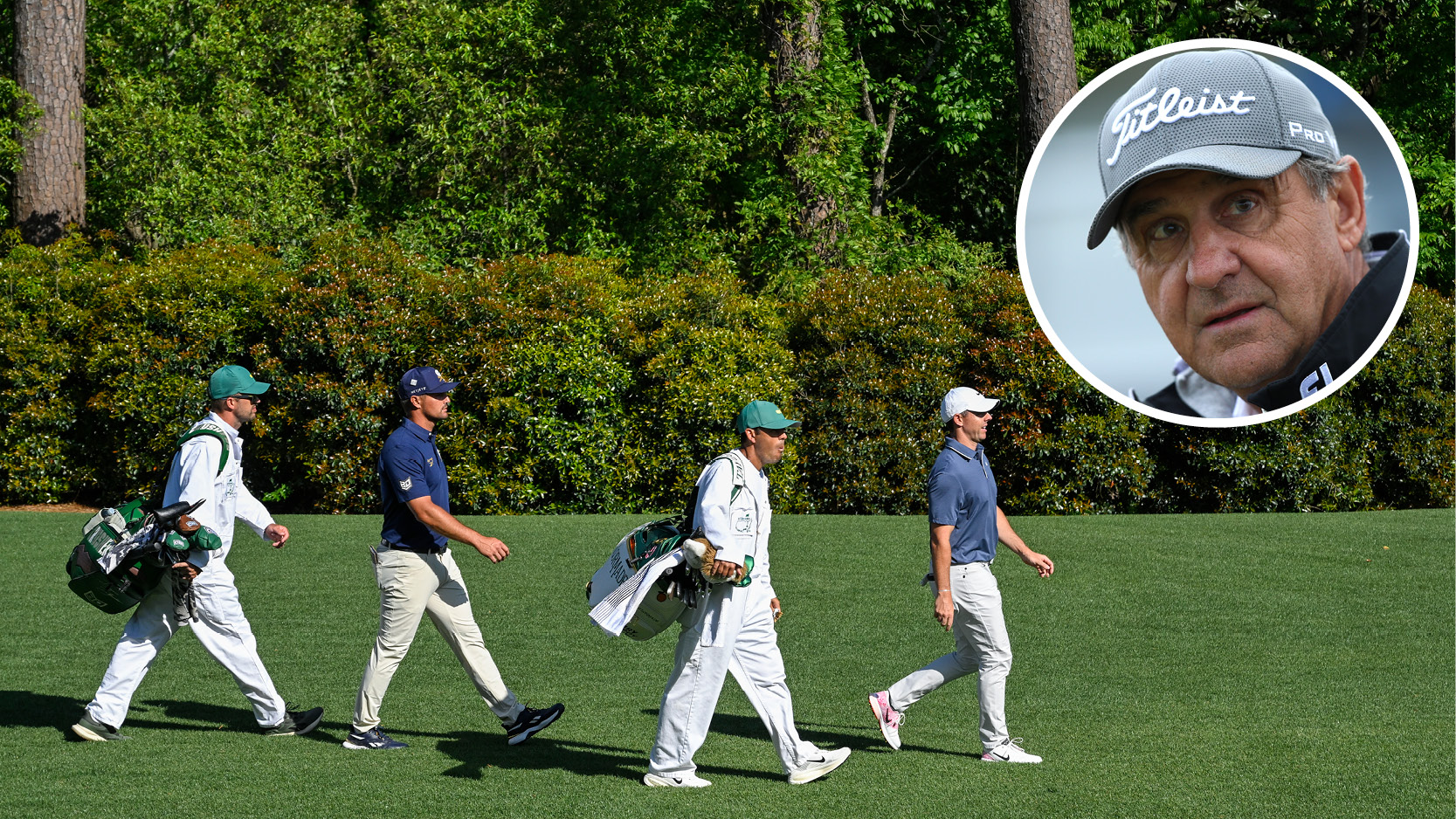Fergus Bisset: LAAC Wednesday
After a slightly stressful journey, Fergus is delighted to have arrived in Mexico


Fergus has touched down in Mexico and is looking forward to covering the sixth, and his fifth, Latin America Amateur Championship.
I’m very fortunate that this is the fifth time I’ve attended the Latin America Amateur Championship.
Since the competition began in 2015, I’ve only missed one – last year’s in the Dominican Republic.
It’s a tremendous event and one I look forward to every year.
Not only is it as slickly run as any golf tournament on the planet (what would else would you expect with The R&A, The Masters and the USGA in charge of proceedings,) but it’s also the friendliest golfing event one could hope to attend.
There’s a great atmosphere amongst players, coaches, organisers, even the usually cynical media.
That’s because everybody is aware just what a great thing for golf the LAAC is.
Get the Golf Monthly Newsletter
Subscribe to the Golf Monthly newsletter to stay up to date with all the latest tour news, equipment news, reviews, head-to-heads and buyer’s guides from our team of experienced experts.
It’s evident from the swift growth and success of the tournament that it is having a tremendous impact in growing the game in this region.
The players have the chance to experience top-level elite golf (they’ll see no competition more impressively organised outside the Majors.)
Plus, they have the opportunity to win some amazing prizes:
The LAAC champion receives an invitation to compete in the 2020 Masters at Augusta National Golf Club and, for the first time, will automatically qualify for The 149th Open at Royal St George’s.
The winner also receives full exemptions into The Amateur Championship, U.S. Amateur Championship and any other USGA amateur championship for which he is eligible and is exempt into the final stages of qualifying for the 120th U.S. Open Championship at Winged Foot.
Runner(s)-up will be exempt into the final stages of qualifying for The 149th Open and the 120th U.S. Open Championship.
I enjoy the LAAC hugely as I get the chance to see some high-quality golf and maybe an early glimpse of some stars of the future.
Two years ago, In Santiago, I watched Joaquin Niemann win in Chile and predicted then that he would be a successful professional.

Some rare proof that I do actually have reasonable judgement; he is now on the verge of breaking into the World’s top-50.
But enough about my (not exactly earth-shattering) foresight… It was basically like seeing a young Lionel Messi running rings around his pals in the playground and saying, “that lad might be quite good when he grows up.”
This year we’re in Mayakoba, Mexico for the sixth LAAC and, from what I’ve seen so far, it’s a very nice place to be indeed.
It’s a beautiful area on the Caribbean coast near Cancun, the weather is 27 deg C and there’s a pleasant breeze.
The Greg Norman designed, El Camaleon, course looks as good in the flesh as it always has when I’ve seen it in the Mayakoba Classic and I can confirm the food in the media and players’ restaurant is top drawer.
Over the last six years, the LAAC has taken me to Buenos Aires, Panama, the Dominican Republic, Chile and now Mexico.
A feature of the trips has been the length of the journey which, for me as a relatively inexperienced traveller, always pans out to be an adventurous one.
Yesterday’s was no different.
I felt pretty comfortable that I had everything well organised and I arrived at Aberdeen airport in plenty of time.
At the check-in desk, the friendly chap looked at my passport and then said, “Great; off to Cancun and going via Miami…”
“That’s right,” I replied.
“Great. Will you be travelling on an ESTA or a visa?”
Wait a minute… This must be a mistake I thought – I’m not going to the States.
“Erm, neither,” I tentatively replied – I’m going to Mexico.”
“Yes, but you need to clear U.S. Customs to connect in Miami.”
Oh dear, what a plonker – Cue 45 minutes of frantic internet activity to secure an emergency ESTA…
I found an agency who would process in an hour, which was pretty impressive given it was 2am U.S. Eastern time and, after a lot of email refreshing, stressing and sweating, confirmation came through just in time for me to check in.
The rest of the journey would be a total breeze, or so I thought.
I made the connection at Heathrow with about three minutes to spare after some justified queue barging, brandishing an orange “Express connection” docket.
Safely on the flight to Miami, with correct paperwork, I then thought the dramas were surely over.
Still all good when I arrived at Miami with 1 hour 45 mins until the connection to Cancun.
But when another “Express” orange docket was thrust into my hand as I left the plane, I began to suspect the fun wasn’t over.
Quite a lot of people had those orange dockets and the queue at the “Express Connection” line at immigration was a smidgen short of express.
I made it through in about an hour and then had to stampede over families and old people to get back through security.
I ran through the terminal and got onto the plane seconds before they closed it.
Other than sitting still on the flights, the full remainder of the journey had been spent stressing, queuing, running, queue barging and stressing a little more.
I was, then, incredibly glad to check into the exceptionally luxurious Andaz Hotel at Mayakoba, which is really very nice indeed.
And today, feeling refreshed, I’ve come to the course to watch some of the practice and get a feel for the layout.
First impressions are that, as you would generally see from a Greg Norman track, there will be a premium placed on straight driving.
The course isn’t overly long at 7,000 yards from the backs but anything offline from the tee is dead.
Almost all the fairways are lined by impenetrable mangroves and these are marked as lateral penalty areas.
Basically, leave the mown surfaces and it’s a shot gone.
Other than that, there are further hazards provided by the canals that traverse the course and, often these will demand a strategic approach.
The 17th hole particularly caught my attention.
The tee shot is an extremely daunting one – The drive must carry a water hazard that bites into the fairway and then find a narrow landing area with more water left and penalty area right.
It had me hyperventilating just watching a couple of groups driving off.
The greens and surrounds don’t appear overly severe and I think the scoring could be decent from those able to produce a consistently straight ball.
The wind might be a factor though, particularly on the holes that come closest to the coastline.
There was quite a difference to be noted when you emerged from the mangrove to the shoreline on the attractive short 15th.
If it gets any stronger than the 15mph or so it is today, it could be tricky.
The first groups tee off tomorrow morning at 7.45am and I’m looking forward to the competition starting properly.
There’s a strong field this year with a large number of players who are either attending or have attended U.S. Colleges on the start list.
In fact, no fewer than 56 of the 108 players fall into one of those categories.
It’s an indication of the opportunities this event has afforded to young players in this region.
I remember in 2015 seeing a number of College coaches spectating and clearly scouting the talent.
It was clear then the level of talent was extensive, and this has been confirmed.
One thing’s for sure, the player who ends the week as champion, will have had to post four excellent rounds and will have the chance of a great golfing future ahead of him.

Fergus is Golf Monthly's resident expert on the history of the game and has written extensively on that subject. He has also worked with Golf Monthly to produce a podcast series. Called 18 Majors: The Golf History Show it offers new and in-depth perspectives on some of the most important moments in golf's long history. You can find all the details about it here.
He is a golf obsessive and 1-handicapper. Growing up in the North East of Scotland, golf runs through his veins and his passion for the sport was bolstered during his time at St Andrews university studying history. He went on to earn a post graduate diploma from the London School of Journalism. Fergus has worked for Golf Monthly since 2004 and has written two books on the game; "Great Golf Debates" together with Jezz Ellwood of Golf Monthly and the history section of "The Ultimate Golf Book" together with Neil Tappin , also of Golf Monthly.
Fergus once shanked a ball from just over Granny Clark's Wynd on the 18th of the Old Course that struck the St Andrews Golf Club and rebounded into the Valley of Sin, from where he saved par. Who says there's no golfing god?
-
 Volvo China Open 2025 Picks, Odds And Predictions
Volvo China Open 2025 Picks, Odds And PredictionsFollowing a break for The Masters, the DP World Tour returns for the final two weeks of its Asian Swing and the Volvo China Open is the penultimate event
By Jonny Leighfield
-
 Rory McIlroy's Sports Psychologist Explains Why He 'Didn't Talk' To Bryson DeChambeau In Masters Final Round
Rory McIlroy's Sports Psychologist Explains Why He 'Didn't Talk' To Bryson DeChambeau In Masters Final RoundDeChambeau raised eyebrows at Augusta National when claiming that McIlroy wouldn't engage in conversation during the final round of The Masters
By Jonny Leighfield